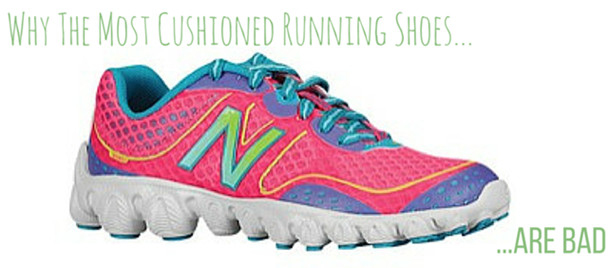The most cushioned running shoes are heavy! Heavy running shoes increases ground contact time and force production during running, therefore contributing to injury.
What does this mean for runners who heel strike?
Heel striking in itself, is associated with high ground contact time and force production as compared with forefoot running. Nonetheless, the added weight of a running shoe will only worsen impact-related variables of heel strike running.
Why The Most Cushioned Running Shoes are Bad for Runners
A study by McCallion et al. examined the effects of a thickly cushioned running shoe, a minimalist running shoe, and barefoot running on ground contact time in competitive runners and found that the thickly cushioned running shoe literally weighed the runners down.
In their study, ground contact time was greater in the thickly cushioned running shoe than in minimalist footwear, which was greater than barefoot running.
- Previous studies have looked at the effects of long ground contact time in runners and reported that longer ground contact time increases force production, loading, and torque on the lower leg.
- Other work has shown a relationship between the mass of a shoe and greater oxygen consumption which may effect performance capacity.
Other factors that influence ground contact time in running is foot strike pattern whereby heel striking is associated with longer ground contact time compared to midfoot and forefoot striking.
Moreover, heel strikers often wear thicker cushioned, raised heel footwear to absorb the impact at heel strike whereas many midfoot and forefoot strikers wear a flatter, flexible, much lighter shoe.
To Reduce Ground Contact Time, Heel Strikers May Face a Fork in The Road
The above study triggers the response to go minimal, which is very sensible for a midfoot, or a forefoot striker.
Heel strikers, on the other hand, may not be able to physically afford to run in a minimalist shoe since heel striking may be more forceful. Essentially, heel strikers may need all the protection they can get in a shoe.
How can a heel striker reduce ground contact time in hopes to avoid injury?
Heel striking in minimalist footwear is not enough to reduce ground contact time related to heel strike mechanics.
By comparing the results of the study with those of others, a practical strategy to effectively reduce ground contact time would be to adopt a forefoot strike landing pattern.
Or, if you are a heel strike unconcerned with ground-contact time, change nothing. If it’s not broke, don’t fix it.
More From Run Forefoot:
Why Heel Striking Causes Injury
You May Also Like (affiliate links):
References:
McCallion et al., Acute differences in foot strike and spatiotemporal variables for shod, barefoot or mininalist male runners. J Sports Sci Med, 2014; 2(13).
Bretta Riches
BSc Neurobiology; MSc Biomechanics candidate, ultra minimalist runner & founder of RunForefoot. I was a heel striker, always injured. I was inspired by the great Tirunesh Dibaba to try forefoot running. Now, I'm injury free. This is why I launched Run Forefoot, to advocate the health & performance benefits of forefoot running and to raise awareness on the dangers of heel striking, because the world needs to know.
Latest posts by Bretta Riches (see all)
- Does Foot Strike Really Matter in Running? YES! - 17/04/2024
- Heel Lifts Increase Injury in Runners - 16/04/2024
- Are Minimalist Shoes Good for Seniors? YES! - 14/04/2024


Leave a Reply